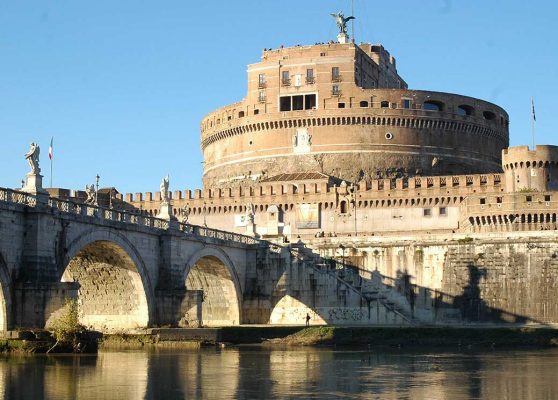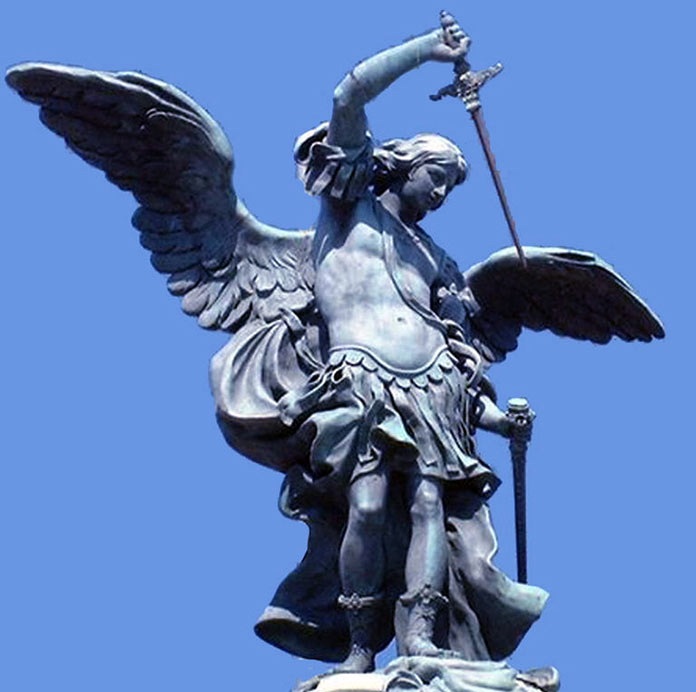Castel Sant’ Angelo
Castel Sant’Angelo, also called Hadrian’s Mausoleum, is a grandiose decorated cylindrical building. It was originally commissioned by the Roman emperor as a tomb for himself and his family.
Built in: 123–139 d.C.
Ordered by: the Emperor Hadrian
Location: in the park called “Parco della Mole Adriana” delimited by the road Piazza Adriana and the bridge Ponte Sant’ Angelo

Top selling tickets on ArcheoRoma
Over the period of almost 1900 years since it was created in the 2nd century AD, this building has changed its role and function many times, as have so many other ancient sites and monuments in Rome. It began its existence as an imperial mausoleum, and was then incorporated into the defensive perimeter of the city walls. Later it was transformed into a fortress and papal residence, a military barracks and a prison. It is now a national museum.
The structure was built in the 2nd century AD by Emperor Emperor Hadrian of the Nerva–Antonine dynasty (who reigned from 117 to 138 AD). It was originally used to house the ashes of Hadrian, his wife Sabina and his first adopted son Lucius Aelius, followed by those of his imperial successors until the Emperor Caracalla of the Severan dynasty, who died in the year 217.
The monument had a similar form to the Mausoleum of Augustus, built a century earlier, which stands half a mile away on the other side of the river. This was where the ashes of the previous Roman emperors and their family members were kept, until the Emperor Nerva, who reigned until 98 AD.
Hadrian, who was known for his interest in architecture, probably planned the mausoleum himself, in collaboration with his personal architect Demetrianus, who also erected the bridge across the Tiber called the Pons Aelius in 134 AD. This bridge gave direct access from the city to the mausoleum and probably also facilitated the transportation of materials for its construction, which was completed in AD 139, during the reign of Hadrian’s successor, Antoninus Pius, when Hadrian’s ashes were placed inside it.
The mausoleum would house the earthly remains of the next four emperors of the Nerva–Antonine dynasty, as well as the first three emperors of the Severan dynasty, ending with Caracalla in 217. In “Memoirs of Hadrian”, her biography of the emperor, Marguerite Yourcenar writes his poetic epitaph: “Little soul, gentle and drifting, guest and companion of my body, now you will dwell below in pallid places, stark and bare; there you will abandon your play of yore. (..) Let us try, if we can, to enter into death with open eyes.”
The monument consisted of a massive square base with sides 89 meters long rising to a height of 15 meters, which supported a cylindrical tower with a diameter of 64 meters and a height of 21 meters. This was covered with a mound of earth where a grove of cypress trees grew in the centre of which was a square tower or temple surmounted by a statue of the Emperor Hadrian in the guise of Helios, the Greek god of the sun, driving a quadriga, a chariot drawn by four horses.
In fact Hadrian belonged to the gens Aelia and his family name, Aelius, sounds like Helios. The Pons Aelius bridge (now called Ponte Sant’Angelo) took its name from his family and Pons Aelius is the original name of Newcastle on Tyne, founded by Hadrian during his visit to Britain in 122 AD when he decided to built his famous wall across the north of England.
It is possible that the famous four gilded horses from the facade of St Mark’s Basilica in Venice, were originally made for Hadrian’s chariot, before being taken to the Hippodrome of Constantinople. They came to Castel Sant’Angelo in 1917 for safekeeping during the war, before being returned to Venice.
The building was surrounded by a balustrade or railings supported by pilasters upon which perched gilded bronze peacocks, two of which are now kept in the Vatican Museums. It was mainly built of concrete (opus caementicium) faced with white travertine and marble decorations, including the epitaphs of those buried inside and a frieze of ox-skulls and festoons, a typical motif on Roman funerary monuments.
We know that it was also adorned with many statues, as the 6th century Byzantine historian Procopius describes bronze groups of men with horses on the four corners of the base. He also says that during the siege by the Goths in 537 the defenders of Rome used pieces of the statues as makeshift projectiles to fend off the attackers.
Following the construction of the Aurelian walls, between 270 and 275 AD, the mausoleum of Hadrian was fortified and incorporated into this new defensive perimeter raised to protect the city of Rome during a period of growing political uncertainty and threat of invasion. Nevertheless it was desecrated by the Visigoths under Alaric who scattered the imperial ashes when they sacked Rome in 410.
In winter 590 a legendary event took place that would give the mausoleum its new name. The newly appointed pope (and future saint) Gregory the Great organized a procession through the city to pray for the end of a pestilence. Penitents starting out from seven different churches proceeded towards Saint Peter’s basilica with the Pope at their head. According to the legend as they crossed the bridge in front of Hadrian’s mausoleum an archangel appeared on top of the castle who appeared to be sheathing his sword.
This was interpreted as a sign that the epidemic was over. Thanks to this apparition people started calling the mausoleum Castel Sant’Angelo (literally: Holy Angel Castle). The statue of an angel now stands at the top of the building to commemorate this miraculous occurrence.
Meanwhile its transformation into a papal fortress continued. In the mid 9th century, following a Saracen raid in 846, Pope Leo IV built a defensive perimeter wall enclosing the Vatican and Saint Peter’s basilica, which was connected with the castle, and in 1277 Pope Nicholas III of the powerful Orsini family directly linked the castle to the Vatican by building an 800-metre-long elevated passageway called the Passetto di Borgo, which could be used as an escape route for popes in danger. Pope Nicholas V (1447-1455) built three bastions at the corners of the square base and also fitted out the castle with sumptuous rooms.
The Borgia pope Alexander VI (1492-1503) commissioned the architect Antonio da Sangallo the Elder to apply the most up-to-date fortification techniques and accordingly four projecting pentagonal bastions were built, dedicated to the Saints Evangelists, incorporating the previous structures built under Nicholas V. A cylindrical tower was raised at the mouth of the bridge and a moat was dug and filled with the waters of the Tiber.
Pope Clement VII fled to the fortress along the Passetto di Borgo together with his entourage to escape the mutinous and vengeful German and Spanish troops of Charles V, Holy Roman Emperor, after their commander Charles III, Duke of Bourbon, had been killed during the siege of Rome in 1527. (In his fanciful autobiography the Florentine goldsmith and sculptor Benvenuto Cellini claimed to have shot the duke from the city walls).
While he hid away for seven months, safe in the castle, the pope’s condemnation of the invading troops (many of whom were inspired by Martin Luther’s teachings) did not prevent the city from being ruthlessly looted in the infamous event known as the Sack of Rome (nor did Cellini’s energetic defence of Castel Sant’Angelo prevent him from later being imprisoned in the stronghold). Finally, in 1630 Pope Urban VIII had all the frontal fortifications destroyed, including the Borgia tower, replacing them with an imposing curtain wall and hr transferred the main entrance from the south to the east side.
Even though they were sometimes forced to hide away in a military fortress, the pontiffs made sure that all the possible comforts befitting their station were not lacking. The papal apartments were created in a series of interventions over the centuries and their luxurious rooms were decorated with the fine frescoes and artworks that can still be seen there today. Pope Paul III (1534-1549) oversaw the remodelling of an entire section of the castle into lavish apartments, decorated with magnificent frescoes extolling his virtues.
A spiral ramp, which rose though the centre of the original mausoleum, still leads from the lower levels of the building to the upper floors, where there were also several prison cells and even a torture chamber. Apart from the artist Benvenuto Cellini, another illustrious “guest” of the pope in these cells was the brilliant philosopher and mathematician Giordano Bruno.
His cosmological beliefs in support of the Copernican heliocentric view and his outrageous suggestion that the stars were in fact suns, perhaps with their own orbiting planets, had got him in trouble with the inquisition. He spent the last six years of his life in this prison before his ideas were condemned as heretical and blasphemous and he was hung upside down naked and burned at the stake in Campo de’ Fiori on 17th February of the year 1600.
From its use as a Papal residence and prison, Castel Sant’Angelo was later converted to a military barracks, and in the nineteenth century it was used as a political prison, called by the name of Forte Sant’Angelo.
This is the setting for the third act of Giacomo Puccini’s opera Tosca: the painter Cavaradossi has ended up in the prison for hiding an escaped political prisoner where he is eventually executed and his mistress, Tosca, in desperation, kills himself by jumping off the castle’s ramparts after killing the sadistic and dishonest chief of the papal police chief Baron Scarpia.

In the upper part of the fortress overlooking the panoramic terrace, there is a statue of an angel in the act of putting a sword back in its scabbard, the work of the 18th-century Flemish sculptor Pieter Verschaffelt. The bronze statue replaced an earlier marble version.
The statue depicts the Arcangel Michael, whom Pope Gregory, according to legend, in order to implore divine mercy, arranged a three-day procession in which all the people took part. When they reached the height of Hadrian’s mausoleum, however, the Romans clearly saw a dazzling silhouette standing on its summit; it was the Archangel Michael in all his splendour. The Pope assessed that phenomenon as the announcement of the end of the scourge. It is 29th August 590. That very evening the plague ceases. Hadrian’s mausoleum was renamed the Castle of the Angel.
Castel Sant’ Angelo: your opinions and comments
Have you visited this monument? What does it mean to you? What advice would you give to a tourist?
Castel Sant’ Angelo tickets